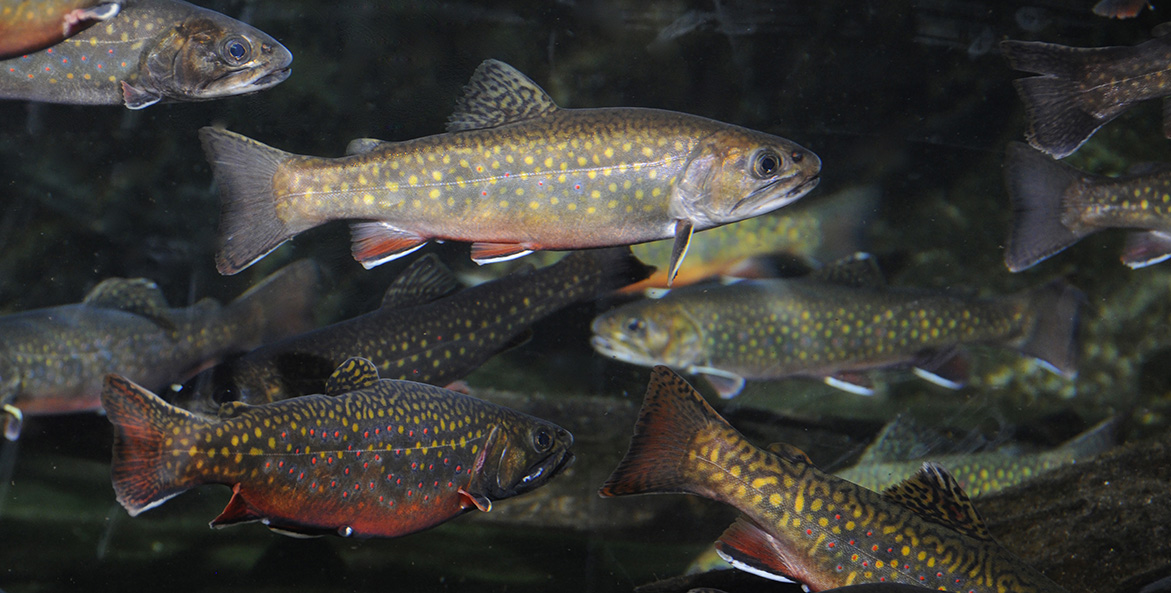"Squishy is good!" Brian Gish calls over his shoulder as our boots sink several inches into the spongy ground. Knee-high ferns obscure the forest floor. Here, at the headwaters of Indian Spring Run, rainwater seeps out of the hills east of Lancaster and feeds a clear, cold stream. In Pennsylvania, clear, cold water means one thing: brook trout.
We find them about a mile downhill, where the stream spills over rocks into a deep pool. Half a dozen trout hover at the bottom. They are slender and six or seven inches long. Bright white lines flash on the fronts of their fins, and we can just barely make out the dazzling technicolor spots and rosy bellies that make these fish a natural wonder.
Gish flicks a line across the water's surface, making the tiny brown fly dance. A bite! The trout is just breaking into the air when it lets go. A darting shadow into the rocks and then it's gone. This happens several more times. Eventually the trout ignore us and the fly.
"Man, I love brookies," Gish says. "They're spunky, they're tenacious. They're survivors."
More than ever, they need to be.
Brook trout once lived in streams along the Appalachian spine of the United States from Georgia to Maine. It is the only trout native to the Chesapeake Bay watershed, and remains the state fish of New York, Pennsylvania, Virginia, and West Virginia. But researchers now estimate just eight percent of watersheds that historically supported brook trout are intact—meaning wild trout are present in at least half of the catchment area.
Indian Spring Run is one of the many streams where brook trout are under threat. It is also one of seven streams targeted for restoration in a comprehensive restoration plan that Gish, CBF's Watershed Coordinator in South Central Pennsylvania, recently completed for the 150-square-mile Pequea Creek watershed in Lancaster and Chester Counties.
"Indian Spring Run has wild brook trout in its headwaters, but numerous impairments—nutrients, siltation, low oxygen, organic enrichment, habitat alterations—in its downstream portions," Gish explains.
The same barrage of challenges is playing out across the Bay watershed. As forests fall to farms and cities, sediment washed into streams can smother the aquatic insects brook trout feed on and bury the gravel beds where they lay their eggs. Nitrogen and phosphorus from fertilizers and manure stimulate excessive algae growth that consumes oxygen when it dies and decomposes. Fast-moving water gushing out of city drains and across farm fields during storms, no longer slowed by trees and undergrowth, can scour away stream banks and trout eggs.
Now, rising temperatures due to climate change are a growing risk. Stream temperature is one of the single best predictors of brook trout, which generally require water no warmer than 68 degrees Fahrenheit. Average annual stream temperatures in the Bay watershed have already increased 1.1 degrees in the past 60 years, and researchers predict more than 1,800 miles of brook trout stream habitat could be lost due to climate change by century's end.
Saving brook trout, and the streams they depend on, is no small feat. But it is possible. The restoration plan Gish authored details a suite of projects and best management practices meant to transform the lower reaches of Indian Spring Run into habitat that could once again support native trout. It requires the cooperation of landowners, and particularly farmers, who can plant forested buffers to protect the stream. The trees and vegetation slow water flowing off the land, preventing sediment and nutrient pollution. Importantly, they also provide cooling shade.
"Farmers are really our greatest allies," Gish says.
We meet with one such farmer, who asks not to be named. The creek here is a clouded brown, flowing through sharply eroded banks. When it rains, it often overflows onto his land—a problem he hopes a stream restoration project will help fix.
"I'm not an environmentalist," he says. "But we want the stream to be clean."
Rising water temperatures threaten native trout.
- Brook trout are the only trout native to the Chesapeake Bay watershed.
- Average annual stream temperature in the Chesapeake Bay watershed has increased by 1.1 degrees Fahrenheit in the past six decades, with some streams warming significantly at 2.1 degrees.
- Rising stream temperatures stress brook trout.




